Hooking the tuba
I’ve tweaked the below posts to display smaller images while providing links to the original hi-res images.
I’ve tweaked the below posts to display smaller images while providing links to the original hi-res images.
A few have accused me of developing a 4X/Civilisation Game. I haven’t discouraged them as in some ways I clearly am, however I’ve also made clear that my focus has been on commerce and investment. What is amusing, and I didn’t realise this until very recently, is the degree to which this design is coming to represent my own views on world history and cultural conquest. For instance there’s no war in Colonial Zoo. There’s also no territorial exploration. War and exploration are staples of standard 4X games but they have no real place in Colonial Zoo and I don’t intend change that. I don’t consider war or exploration to be particularly significant drivers of history and cultural development. No, the simple urge to grow and survive as expressed through commerce is the centre of my view of history, and that is being reflected in Colonial Zoo.
An early stab at the building graph overlaid on the technology graph:
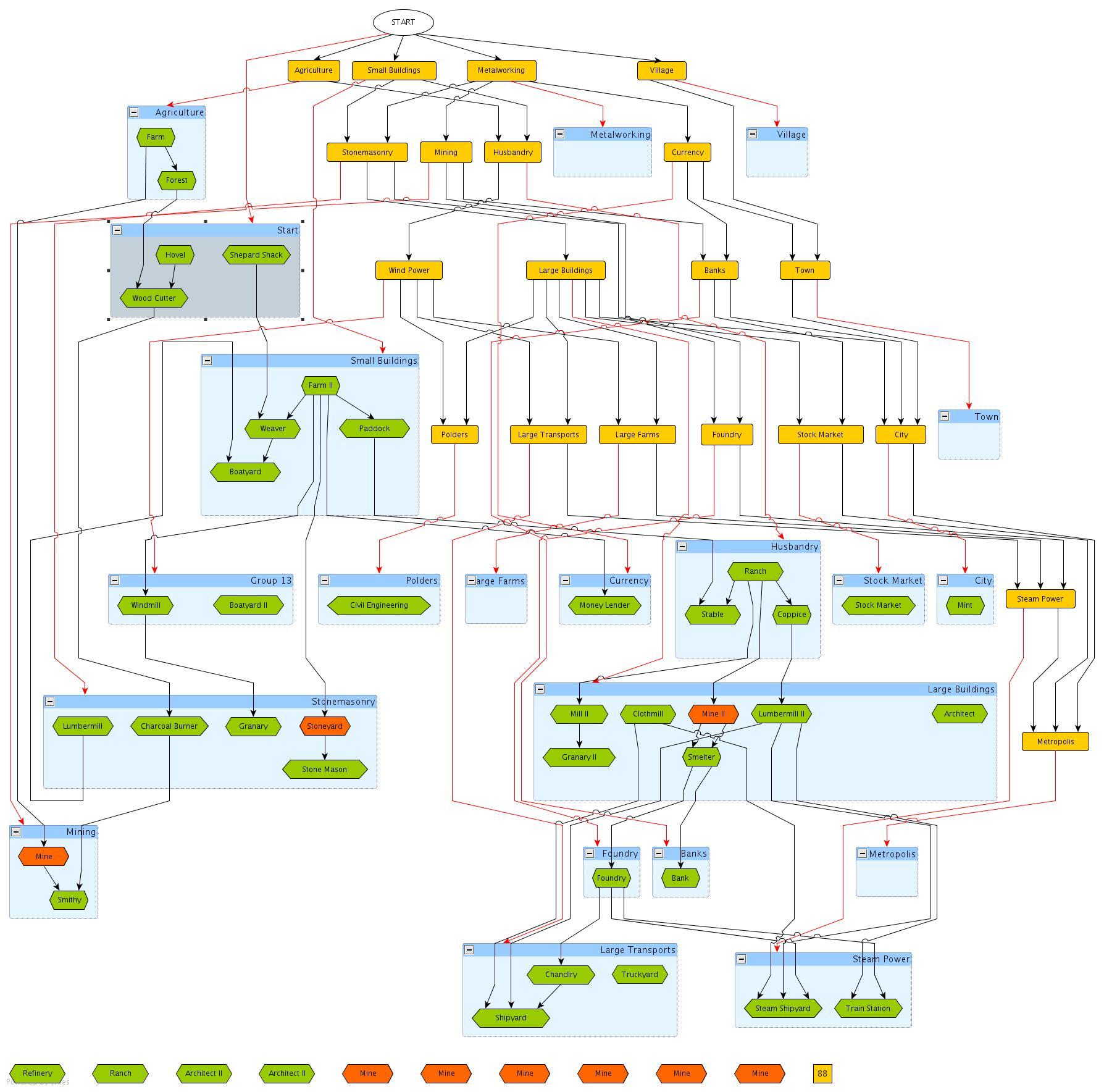
Cleaned up, using groups for technology nodes and heavy solid lines for the tech tree, dashed lines for products_needed_to_build and solid lines for inputs_to-produce:
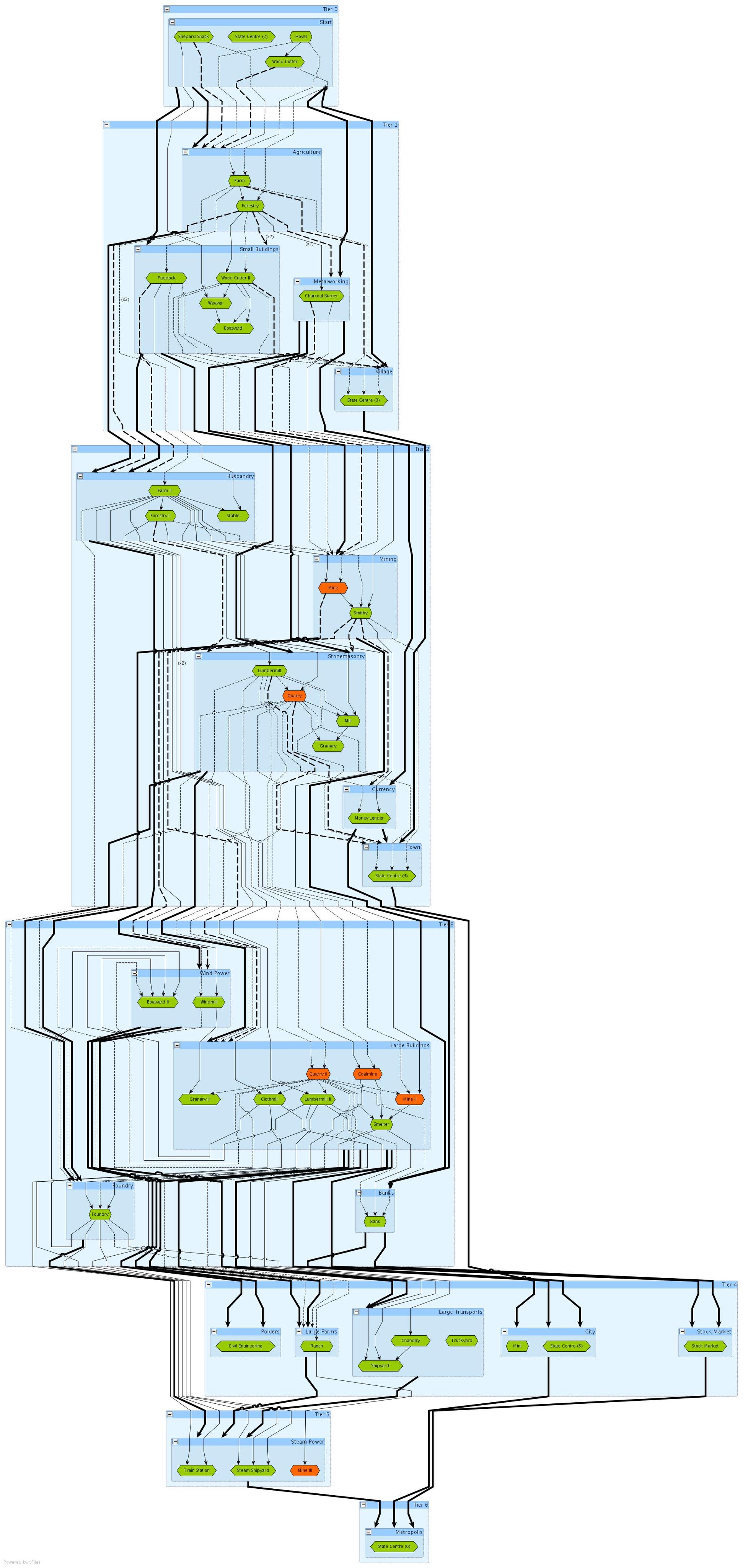
There’s still much to do. I’m also thinking about dropping out a whole technology level – feels like there are too many acts in the play.
Aaron up at Endgame Oakland rather graciously requested a playtest copy of ‘Ohana Proa. This last Wednesday I dropped off a copy of the map. He already had rules and player aids printed. The store stocks all the other bits needed. I’m greatly looking forward to his reports: the Endgame players are perceptive, aggressive, and demanding.
First version of the technology tree:
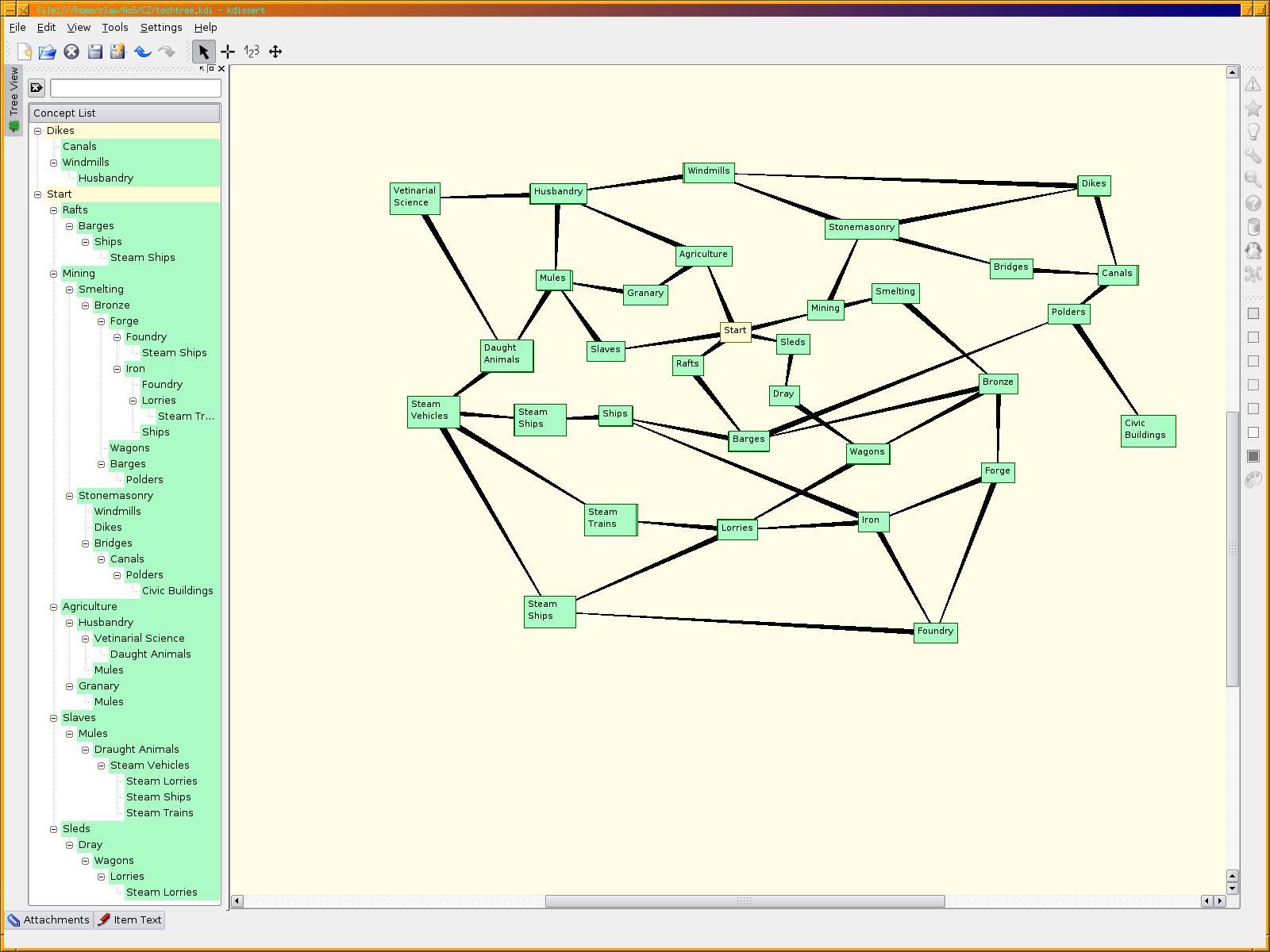
Second pass:
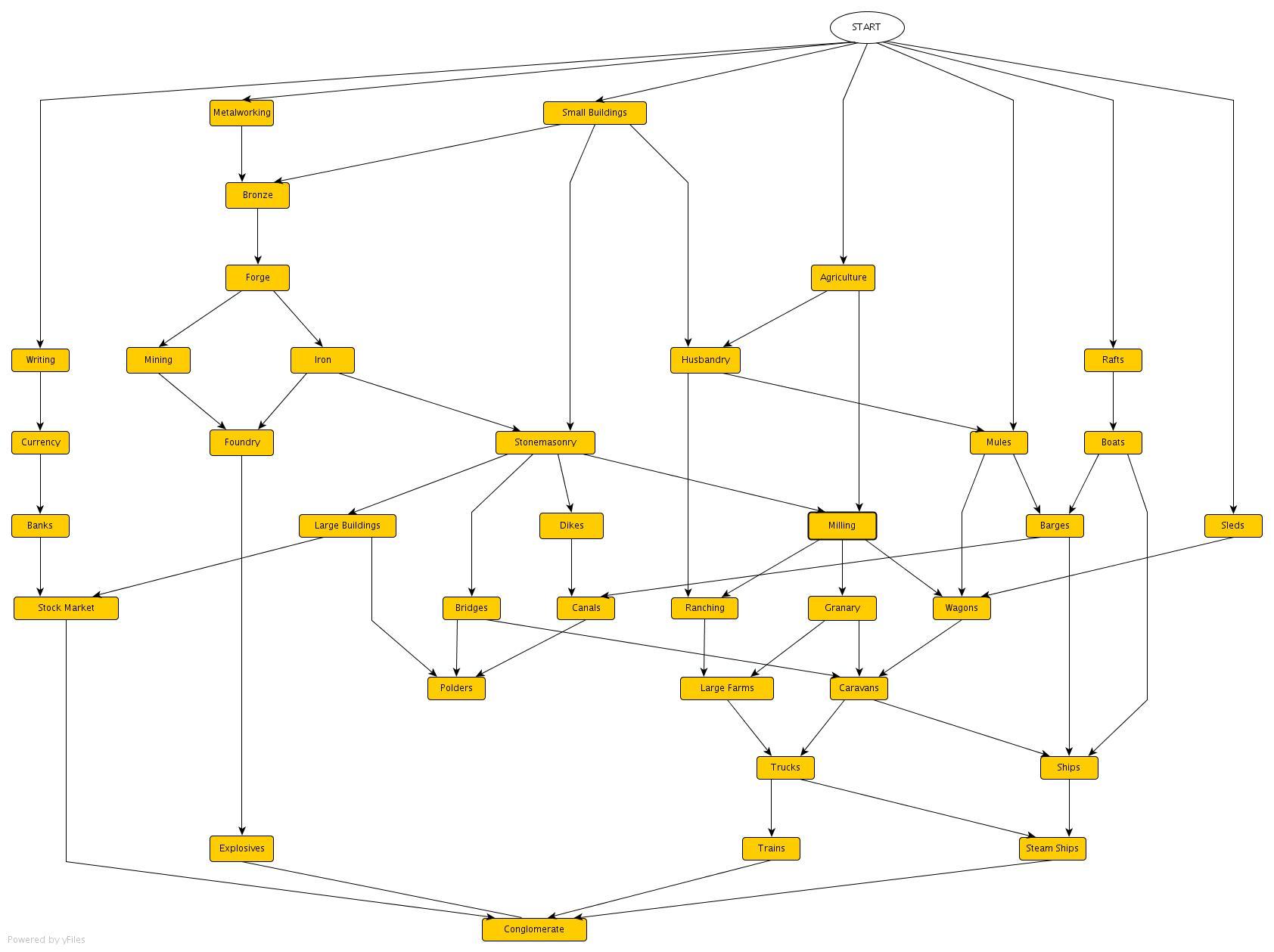
Greatly simplified third pass:
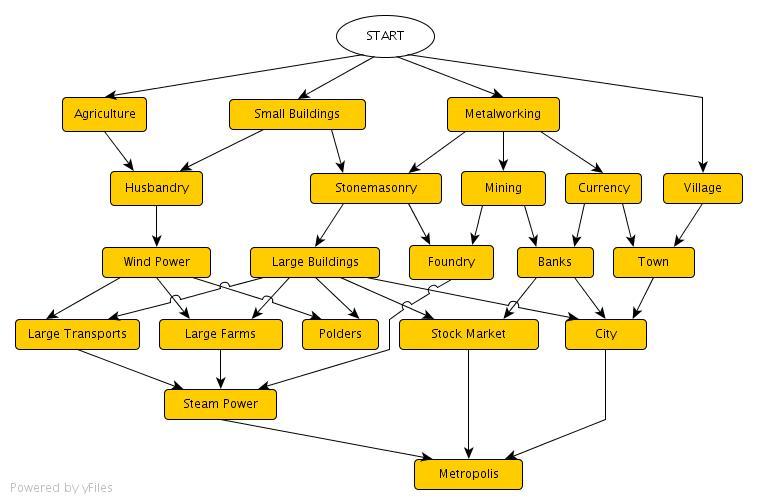
This last version feels to be of about the sight size and complexity for Colonial Zoo.
The first version above was drawn with KDissert, a neat enough mind-mapping tool. However for this use it has the problem that it can’t represent loops. The loops in the above image were made by stacking nodes. Bad.
The second two graphs were made with yED, a spiffy Java-based graph editor.
Someone has created a BGG entry for ‘Ohana Proa. I suspect it was created by one of yesterday’s playtesters.
The dollar auction model mentioned below is attractive but may not be enough. I’m also concerned that the early stages of the game will be relatively uninteresting as the player’s only opportunity is to invest in/build their starting cities, and given the action point bonus of operating in multiple cities, their unfailing interest will be in linking the city states as rapidly as possible with transports.
A new proposal for initial setup:
The square may be too high a proportion. It may also be necessary to force the last/low bidder’s payment to $0 in order to prevent excessive bid inflation: All players bid high in order to flood the setup with early cash. It isn’t clear that this would be a problem however.
An optimisation pass. There’s a large discussion below about building limits, transport connectivity, city centre ranges etc. It is complex. I’m concerned that with buildings flipping ownership as city centres upgrade that tracking ownership boundaries could be needlessly detailed and complex. I really don’t want to introduce border markers or ownership markers. There’s more than enough detail and complexity in the game at that level already to be interesting.
Thus the optimisation pass.
The new model is to just use ranges. A city centre has a range. When it is upgraded its range increases. When a City State has a turn, all buildings within range of its city centres activate. Very simple. Look at the city centre, count outward from there to every building in range: they’re all available even they are also in range of another City State’s city centre. As a side effect city centre upgrades become more interesting. They provide an additional way to control turn order on a micro-level by moving city boundaries and activating buildings more frequently than before. Combined with the new war patterns, this would seem to present some interesting player-driven controls.
Additionally this range model by implication partially resolves an ambiguity around transports and inter-city trade. Just when can a player send a product from one city to another? If only the buildings within range of a city centre are activated, then only those buildings may be used to transmute products. QED. Ergo, an activated building may retrieve an already built product from a remote inactive city to satisfy one of its inputs, but may not send its own products to an inactive building. This model is additionally pleasing as it pushes the consumption choice to post-production versus pre-production. Cleaner, simpler, and more available to borking by other players — what’s not to like?
I’m re-examining the premises for war. I like the idea but am uncertain whether the complexity and detail is justified. This almost certainly means it isn’t justified. Ergo I may end up killing war from the design before I’ve adequately explained to you poor readers what it was before I mercilessly defenestrated it. So be it.
The core concepts of war are simple: City States may construct buildings whose outputs are transport-like devices that can destroy other buildings or transports, or which can take over (conquer) other City State’s city centres.
Destruction of buildings can be useful for land-constrained City States or City States attempting to achieve or maintain a competitive edges over neighbours. Such military units could also be used to sever key Transport connections for competitors or possibly of the host City State so that other/different/more attractive connections could be built instead. Of course once a warship (for example) has been built and the appropriate transports adjusted, the question arises of what to do with it in other later turns and who might use it to do what and where? There are laws about unintended consequences as well as idle militaries.
Conquest however was intended to be the more interesting affair. The core concept was that military units could attempt to penetrate another City State and to conquer its city centre. Should they succeed, then a large portion of the treasury of the losing City state would be divided given to the larger investors in the winning City State. In this way potentially large lumps of cash could be extracted from the game and handed to players. (Investors in the losing City State would have their investment totals transferred over to the winner according to some ratio) On subsequent turns all buildings within range of both/all city centres would activate when that City State had its turn. Thus the result of conquest are several-fold:
I can also imagine tieing city centre count limits to technology level limits of City States. In essence this would be a logically implied branch of the tech tree.
Getting back to the starting position however, what I’m having the most problem with is the war buildings and the war transport-like objects. They just don’t seem justifiable in terms of return for complexity. It will also be difficult to write rules without problems for them. I do like the investment and cash flow effects of war. Those are compellingly interesting.
A thought: Have branches of the tech tree which do nothing but absorb/conquer other City States whose city centres are within range of the tech tree climbing City State city centre.
Hurm. The more I think about this the more I like it. It also ties in well with another post I haven’t finished writing yet on managing building ownership and city centre ranges. I’ll try and get those details posted later today.
I’ve largely assumed that Colonial Zoo maps will not be symmetrical and/or balanced. Some maps may be based on real world maps (Greece and the Baltic appeal to me), and others will be relatively random or artful designs with more concentration on challenge than fairness across multiple players. I have to assume that some positions on the board/map used will simply be better and will give the players that start there an inherent advantage, and that’s a problem.
Intuitively. Age of Steam’s variant on the classic Dollar Auction may be the right approach. The basic model would be that a turn order would be establish randomly and in that turn order the players would each found a City State by positioning a city centre for it somewhere on the map. Once that was done the player order would be randomised yet again and the players would iteratively bid part of their starting money for the initial turn order.. Bidding would proceed rotationally in turn order and upon their turn a player could either up the bid by whatever factor they wish, or drop. If they drop they would take the lowest currently unoccupied place in the turn order. By upping the bid they would remain in the auction for turn order. Once bidding is concluded the first and second place players would pay the full value of their final bids to the bank, the player last in turn order would pay nothing, and those in-between would pay half their final bid rounded up. Once turn order was resolved, in the new turn order the players would exclusively choose which City State they wanted to adopt as their starting position.